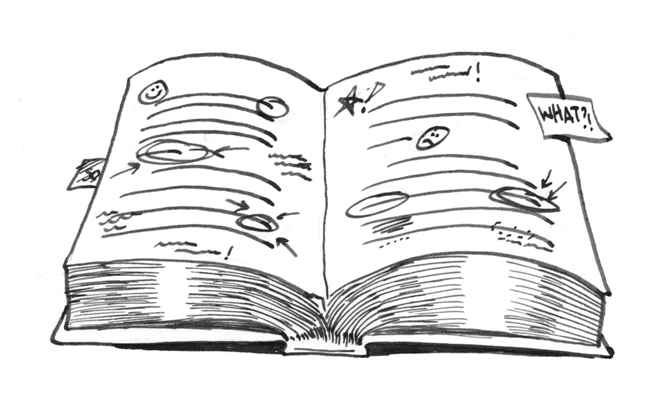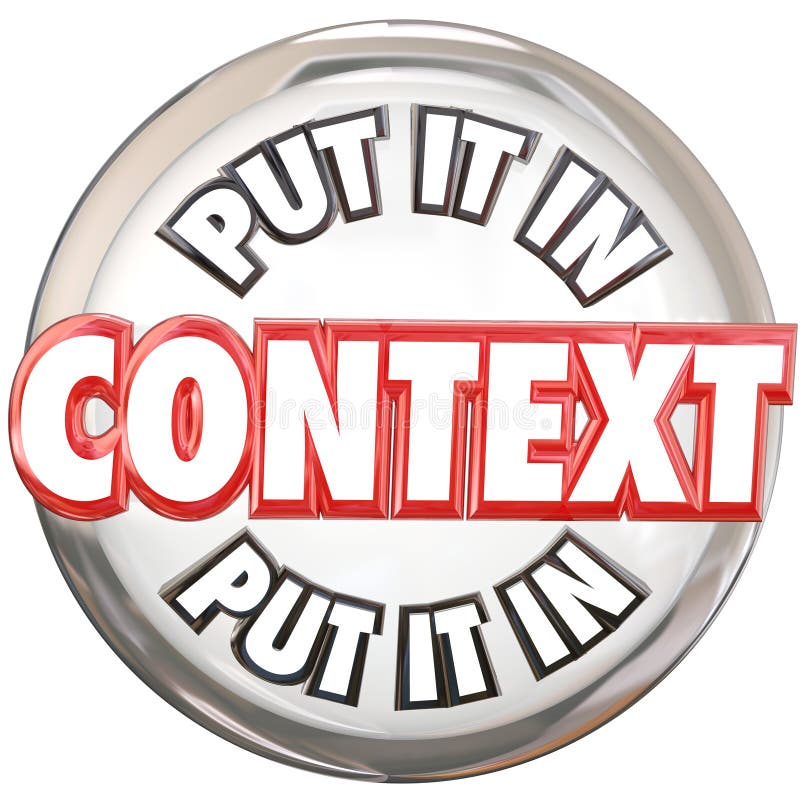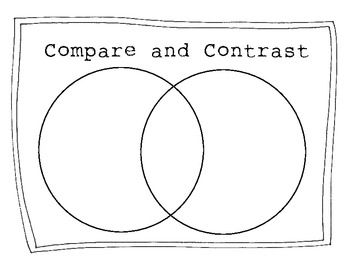
![]() 1. Previewing: Look “around” the text before you start reading. You’ve probably engaged in one version of previewing in the past, when you’ve tried to determine how long an assigned reading is (and how much time and energy, as a result, it will demand from you). But you can learn a great deal more about the organization and purpose of a text by taking note of features other than its length.
1. Previewing: Look “around” the text before you start reading. You’ve probably engaged in one version of previewing in the past, when you’ve tried to determine how long an assigned reading is (and how much time and energy, as a result, it will demand from you). But you can learn a great deal more about the organization and purpose of a text by taking note of features other than its length.
Previewing enables you to develop a set of expectations about the scope and aim of the text. These very preliminary impressions offer you a way to focus your reading. For instance:
 2. Annotating: Make your reading thinking-intensive from start to finish. Annotating puts you actively and immediately in a "dialogue” with an author and the issues and ideas you encounter in a written text. It's also a way to have an ongoing conversation with yourself as you move through the text and to record what that encounter was like for you. Here's how:
2. Annotating: Make your reading thinking-intensive from start to finish. Annotating puts you actively and immediately in a "dialogue” with an author and the issues and ideas you encounter in a written text. It's also a way to have an ongoing conversation with yourself as you move through the text and to record what that encounter was like for you. Here's how:
![]() 3. Outline, summarize, analyze: Take the information apart, look at its parts, and then try to put it back together again in language that is meaningful to you. The best way to determine that you’ve really gotten the point is to be able to state it in your own words.
3. Outline, summarize, analyze: Take the information apart, look at its parts, and then try to put it back together again in language that is meaningful to you. The best way to determine that you’ve really gotten the point is to be able to state it in your own words.
Outlining the argument of a text is a version of annotating, and can be done quite informally in the margins of the text, unless you prefer the more formal Roman numeral model you may have learned in high school. Outlining enables you to see the skeleton of an argument: the thesis, the first point and evidence (and so on), through the conclusion. With weighty or difficult readings, that skeleton may not be obvious until you go looking for it.
Summarizing accomplishes something similar, but in sentence and paragraph form, and with the connections between ideas made explicit.
Analyzing adds an evaluative component to the summarizing process—it requires you not just to restate main ideas, but also to test the logic, credibility, and emotional impact of an argument. In analyzing a text, you reflect upon and decide how effectively (or poorly) its argument has been made. Questions to ask:
4. Look for repetitions and patterns: The way language is chosen, used, positioned in a text can be important indication of what an author considers crucial and what he expects you to glean from his argument. It can also alert you to ideological positions, hidden agendas or biases. Be watching for:
 5. Contextualize: Once you’ve finished reading actively and annotating, take stock for a moment and put it in perspective. When you contextualize, you essentially "re-view" a text you've encountered, framed by its historical, cultural, material, or intellectual circumstances.
5. Contextualize: Once you’ve finished reading actively and annotating, take stock for a moment and put it in perspective. When you contextualize, you essentially "re-view" a text you've encountered, framed by its historical, cultural, material, or intellectual circumstances.
Also view the reading through the lens of your own experience. Your understanding of the words on the page and their significance is always shaped by what you have come to know and value from living in a particular time and place.
 6. Compare and Contrast: Set course readings against each other to determine their relationships (hidden or explicit).
6. Compare and Contrast: Set course readings against each other to determine their relationships (hidden or explicit).
 S = Survey Before you crack open your book to page one and dive in, take a few minutes to read the preface and introduction to the text and browse through the table of contents and the index. This will tell you the main topics that the book will cover, the author's particular approach to the subject (i.e., why he/she wrote another text on the subject when there are probably twenty on the market), and what the basic organizational structure will be.A similar process is repeated before each chapter. Read all the titles and subtitles, study any pictures, charts or graphs, and, if there are any, read the summary at the end of the chapter and any study questions. Surveying a chapter in this way gives you the "big picture;” a framework of the main ideas which will help to hold the details together later.
S = Survey Before you crack open your book to page one and dive in, take a few minutes to read the preface and introduction to the text and browse through the table of contents and the index. This will tell you the main topics that the book will cover, the author's particular approach to the subject (i.e., why he/she wrote another text on the subject when there are probably twenty on the market), and what the basic organizational structure will be.A similar process is repeated before each chapter. Read all the titles and subtitles, study any pictures, charts or graphs, and, if there are any, read the summary at the end of the chapter and any study questions. Surveying a chapter in this way gives you the "big picture;” a framework of the main ideas which will help to hold the details together later.
Q = Question Before beginning to read, take the subtitle of the section (or the first sentence of a paragraph) and turn it into a question. For example, if you're reading part of a chapter called "Functions of the Spinal Cord," ask yourself, "What are the functions of the spinal cord?"
R#1 = Read Then read; not passively sliding your eyes over the words, but actively engaging the text, trying to find the answer to your question. Be cautious, however, that you don't end up skimming for the answer to your question and missing other important information.
R#2 = Respond Once you've read the section, close the textbook and answer your question, either orally or on paper, in your own words. If you can't answer the question, you should re-read that section until you can. If, after several tries, you still can't answer your question, go on to the next few sections and see if things become clearer. You may find that you need to change your question. For example, you may have first posed the question, "What is the Treaty of Versailles?" for the subtitle "The Treaty of Versailles," but, after reading the section, you may find that a better question is, “Why was the Treaty of Versailles created?" If changing your question doesn't help clarify the reading, it's time to get some help. Your instructor or LRC tutors are good places to start.
R#3 = Record Once you've understood the material and can summarize it in your own words, the next step is to record the information in some way. Some common methods are to highlight and/or mark the text, or take notes, or some combination of both. Whichever method or combination of methods you choose (some pros and cons are summarized next), it's critical to remember to read and understand the material first and then go back and record.
MYTH 1: I DIDN'T READ IN HIGH SCHOOL SO I DON'T NEED TO READ IN COLLEGE

Seriously? You want to succeed in college don't you? While it may seem for some classes you just need to take lecture notes and you can "get by," that will definitely NOT work for all classes. Even in those classes where you take only lecture notes, you are missing a large component of information by skipping course readings. Information that could help you get an A and understand content more effectively as well as information that will make you an expert in your chosen field of study. DO NOT SKIP THE READING!
MYTH 2: I HAVE TO READ EVERY WORD
Many of the words used in writing grammatically correct sentences actually convey no meaning. If, in reading, you exert as much effort in conceptualizing these meaningless words as you do important ones, you limit not only your reading speed but your comprehension as well.
MYTH 3: READING ONCE IS ENOUGH
Skim once as rapidly as possible to determine the main idea and to identify those parts that need careful reading. Reread more carefully to plug the gaps in your knowledge. Many college students feel that something must be wrong with their brain power if they must read a textbook chapter more than once. To be sure, there are students for whom one exposure to an idea in a basic course is enough, but they either have read extensively or have an excellent background or a high degree of interest in the subject. For most students in most subjects, reading once is not enough. However, this is not to imply that an unthinking Pavlovian-like rereading is necessary to understand and retain materials. Many students automatically regress or reread doggedly with a self-punishing attitude. ("I didn't get a thing out of that paragraph the first time, so if I punish myself by rereading it maybe I will this time.") This is the hardest way to do it. Good reading is selective reading. It involves selecting those sections that are relevant to your purpose in reading. Rather than automatically rereading, take a few seconds to quiz yourself on the material you have just read and then review those sections that are still unclear or confusing to you. The most effective way of spending each study hour is to devote as little time as possible to reading and as much time as possible to testing yourself, reviewing, organizing, and relating the concepts and facts, mastering the technical terms, formulas, etc., and thinking of applications of the concepts-in short, spend your time learning ideas, not painfully processing words visually.
MYTH 4: IF I SKIM OR READ TOO RAPIDLY MY COMPREHENSION WILL DROP
Many people refuse to push themselves faster in reading for fear that they will lose comprehension. However, research shows that there is little relationship between rate and comprehension. Some students read rapidly and comprehend well, others read slowly and comprehend poorly. Whether you have good comprehension depends on whether you can extract and retain the important ideas from your reading, not on how fast you read. If you can do this, you can also increase your speed. If you "clutch up" when trying to read fast or skim and worry about your comprehension, it will drop because your mind is occupied with your fears and you are not paying attention to the ideas that you are reading. If you concentrate on your purpose for reading -- e.g. locating main ideas and details, and forcing yourself to stick to the task of finding them quickly -- both your speed and comprehension could increase. Your concern should be not with how fast you can get through a chapter, but with how quickly you can locate the facts and ideas that you need.